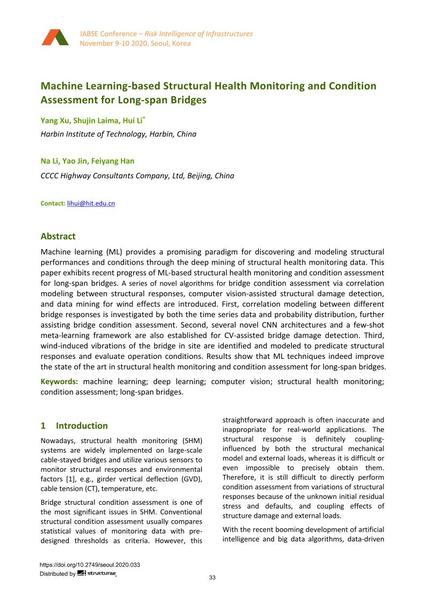Machine Learning-based Structural Health Monitoring and Condition Assessment for Long-span Bridges

|
|
|||||||||||
Bibliografische Angaben
| Autor(en): |
Yang Xu
(Harbin Institute of Technology, Harbin, China)
Shujin Laima (Harbin Institute of Technology, Harbin, China) Hui Li (Harbin Institute of Technology, Harbin, China) Na Li (Harbin Institute of Technology, Harbin, China) Yao Jin (Harbin Institute of Technology, Harbin, China) Feiyang Han (CCCC Highway Consultants Company, Ltd, Beijing, China) |
||||
|---|---|---|---|---|---|
| Medium: | Tagungsbeitrag | ||||
| Sprache(n): | Englisch | ||||
| Tagung: | IABSE Conference: Risk Intelligence of Infrastructures, Seoul, South Korea, 9-10 November 2020 | ||||
| Veröffentlicht in: | IABSE Conference Seoul 2020 | ||||
|
|||||
| Seite(n): | 33-41 | ||||
| Anzahl der Seiten (im PDF): | 9 | ||||
| DOI: | 10.2749/seoul.2020.033 | ||||
| Abstrakt: |
Machine learning (ML) provides a promising paradigm for discovering and modeling structural performances and conditions through the deep mining of structural health monitoring data. This paper exhibits recent progress of ML-based structural health monitoring and condition assessment for long-span bridges. A series of novel algorithms for bridge condition assessment via correlation modeling between structural responses, computer vision-assisted structural damage detection, and data mining for wind effects are introduced. First, correlation modeling between different bridge responses is investigated by both the time series data and probability distribution, further assisting bridge condition assessment. Second, several novel CNN architectures and a few-shot meta-learning framework are also established for CV-assisted bridge damage detection. Third, wind-induced vibrations of the bridge in site are identified and modeled to predicate structural responses and evaluate operation conditions. Results show that ML techniques indeed improve the state of the art in structural health monitoring and condition assessment for long-span bridges. |
||||
| Stichwörter: |
Bestandsbewertung
|
||||
